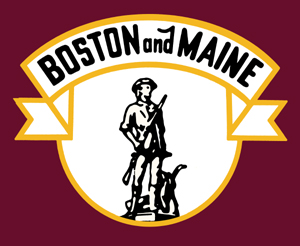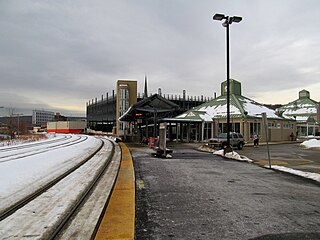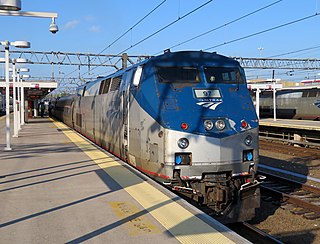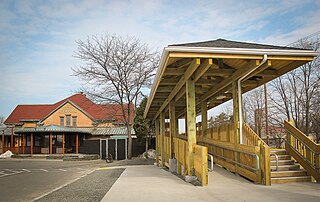
The Boston and Maine Railroad was a U.S. Class I railroad in northern New England. Originally chartered in 1835, it became part of what was the Pan Am Railways network in 1983.

The Hoosac Tunnel is a 4.75-mile (7.64 km) active railroad tunnel in western Massachusetts that passes through the Hoosac Range, an extension of Vermont's Green Mountains. It runs in a straight line from its east portal, along the Deerfield River in the town of Florida, to its west portal, in the city of North Adams.

The Troy and Greenfield Railroad, chartered in 1848, ran from Greenfield, Massachusetts, United States, to the Vermont state line. It was leased to the Troy and Boston Railroad in 1856, then consolidated into Fitchburg Railroad 1887 which in turn was acquired by Boston and Maine Railroad by lease in 1900.

The Fitchburg Railroad is a former railroad company, which built a railroad line across northern Massachusetts, United States, leading to and through the Hoosac Tunnel. The Fitchburg was leased to the Boston and Maine Railroad in 1900. The main line from Boston to Fitchburg is now operated as the MBTA Fitchburg Line; Pan Am Railways runs freight service on some other portions.
The Central Massachusetts Railroad was a railroad in Massachusetts. The eastern terminus of the line was at North Cambridge Junction where it split off from the Middlesex Central Branch of the Boston and Lowell Railroad in North Cambridge and through which it had access to North Station in Boston. From there, the route ran 98.77 miles west through the modern-day towns of Belmont, Waltham, Weston, Wayland, Sudbury, Hudson, Bolton, Berlin, Clinton, West Boylston, Holden, Rutland, Oakham, Barre, New Braintree, Hardwick, Ware, Palmer, Belchertown, Amherst, and Hadley to its western terminal junction at N. O. Tower in Northampton with the Connecticut River Railroad.

The Fitchburg Line is a branch of the MBTA Commuter Rail system which runs from Boston's North Station to Wachusett station in Fitchburg, Massachusetts. The line is along the tracks of the former Fitchburg Railroad, which was built across northern Massachusetts, United States, in the 1840s. Winter weekend service includes a specially equipped seasonal "ski train" to Wachusett Mountain.

Springfield Union Station is a train and bus station in the Metro Center area of Springfield, Massachusetts. Constructed in 1926, Springfield Union Station is the fifth-busiest Amtrak station in the Commonwealth, and the busiest outside of Greater Boston.
The Lexington and West Cambridge Railroad was a railroad company chartered in 1845 and opened in 1846 that operated in eastern Massachusetts. It and its successors provided passenger service until 1977 and freight service until 1980 or early 1981.

Silver Hill station was an MBTA Commuter Rail Fitchburg Line station in Weston, Massachusetts, United States. The station had a small shelter, parking area, and a gravel boarding area; it was not accessible. It was the least-used station in the entire MBTA system in 2018, with an average of just eleven daily boardings. Silver Hill station opened in 1844 as one of the original stops on the Fitchburg Railroad. The Boston and Maine Railroad unsuccessfully attempted to close the station in 1959. It remained in use until its temporary closure by the Massachusetts Bay Transportation Authority (MBTA) in December 2020 due to low ridership and a lack of accessibility, with indefinite closure effective April 2021.

Ayer station is an MBTA Commuter Rail station located off Main Street in the Ayer Main Street Historic District of Ayer, Massachusetts. It serves the Fitchburg Line. There are three tracks through the station, two of which are served by a pair of low-level side platforms, which are not accessible. There is a shelter on the inbound platform.

The Fitchburg Intermodal Transportation Center is a regional rail and bus station located in downtown Fitchburg, Massachusetts. It is a stop on the MBTA Commuter Rail Fitchburg Line and a hub for Montachusett Regional Transit Authority local and intercity bus routes.

The Hartford Line is a train service run by Amtrak primarily between Springfield, Massachusetts, and New Haven, Connecticut, along Amtrak's New Haven–Springfield Line.

Williamstown Rail Yard and Station Historic District is a historic district at the junction of Cole Avenue and N. Hoosac Road in Williamstown, Massachusetts.The rail yard was an important junction point for the railroads of the area in the late 19th century, serving as the western terminus for trains passing through the Hoosac Tunnel to points east. The yard's facilities included a locomotive repair shop and a railroad roundhouse, although the latter has not survived. The district was listed the National Register of Historic Places in 1994.

The John W. Olver Transit Center, also called the JWO Transit Center, is an intermodal transit hub for Franklin County, Massachusetts. Located in Greenfield, it currently serves Franklin Regional Transit Authority (FRTA) local bus routes plus intercity bus service. Amtrak's Greenfield station is also located here, with one daily Vermonter round trip and two daily Valley Flyer round trips, which are extensions of Amtrak-run Hartford Line trains.

Union Station is a historic building in Northampton, Massachusetts, that served as a train station from 1897 until 1987. Built at the close of the nineteenth century, the structure incorporates many features of the Richardsonian Romanesque architectural style. The buff brick masses of the station are trimmed with red Longmeadow brownstone and hooded by red tile roofs. Steep dormers protrude from the roofline. The interior once featured Italian marble floors, oak woodwork, and a large fireplace.

The Connecticut River Line is a railroad line owned by the Massachusetts Department of Transportation (MassDOT), running between Springfield and East Northfield, Massachusetts.

Lake Street station was a commuter rail station on the Lexington Branch, located in the East Arlington section of Arlington, Massachusetts. The line opened as the Lexington and West Cambridge Railroad in 1846, with a station at Pond Street among the earliest stops. It was renamed Lake Street in 1867. The Boston and Lowell Railroad (B&L) acquired the line in 1870 and built a new station building in 1885. Service continued under the Boston and Maine Railroad (B&M) – successor to the B&L – though it declined during the 20th century. Lake Street station and three others on the line were closed in May 1958. The Massachusetts Bay Transportation Authority (MBTA) began subsidizing service in 1965, and Lake Street station reopened in March 1968. All passenger service on the Lexington Branch ended on January 10, 1977; it was converted into the Minuteman Bikeway in the early 1990s.
The Green Mountain Flyer was an international day train between Montreal, Quebec, Canada, and the Northeast United States, with sections to New York City and Boston. It was operated in cooperation between the Rutland Railroad, the Canadian National Railway and the New York Central Railroad. The train carried the number 65 running north, and number 64 running south. The Mount Royal was the night train counterpart to the Green Mountain Flyer. Following years of cutbacks, both trains were discontinued in 1953 when the Rutland Railway ended all passenger service.

Union Station was the main passenger railroad station of Troy, New York until it went out of service in 1958. A Beaux-Arts building, designed by Reed & Stem and completed ca. 1903, it served the New York Central Railroad (NYC), the Boston and Maine Railroad (B&M) and the Delaware and Hudson Railroad (D&H). This was the fourth union station in Troy. The tracks approaching the station were but feet away from homes. It stretched from Broadway to Fulton streets, on the block east of Union Street.

The Connecticut Yankee was a long-distance train in western New England, that in its first two decades was an international night train, established in 1936, that extended from New York City into southeastern Quebec, to Sherbrooke and Quebec City, a 549-mile (884 km) trip. The pooled train covered railroad territories of the New York, New Haven and Hartford, Boston and Maine, Canadian Pacific Railway and the Quebec Central Railway. It was the last U.S.-Canadian train serving the Sherbrooke to eastern Vermont route.















